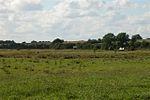Dybbøl

Dybbøl is a small town with a population of 2,356 (1 January 2023) in the southeastern corner of South Jutland, Denmark. It is located around 6 km (3.7 mi) west of Sønderborg. It is mainly known for being the site of a famous last stand battle in 1864. During the Second Schleswig War in 1864, the Danish Army withdrew from the traditional fortified defence line, the Dannevirke (after waters and marshes which supported its flanks froze solid in a hard winter), and marched for Dybbøl to find a more defensible position. Although much artillery was abandoned and the evacuation was executed through a snow-laden north gale in winter, the army arrived almost intact. It entrenched itself at the Dybbøl trenches, which became the scene of the siege and subsequent Battle of Dybbøl (7 April – 18 April 1864). This battle resulted in a Prussian-Austrian victory over Denmark. In the following peace settlement, Denmark surrendered Schleswig. Following World War I, Denmark recovered the northern part of Schleswig as a result of the Schleswig Plebiscites as described in the Treaty of Versailles. The Dybbøl Mill is considered a Danish national symbol.
Excerpt from the Wikipedia article Dybbøl (License: CC BY-SA 3.0, Authors, Images).Dybbøl
Femvej, Sønderborg Municipality
Geographical coordinates (GPS) Address Nearby Places Show on map
Geographical coordinates (GPS)
| Latitude | Longitude |
|---|---|
| N 54.911111111111 ° | E 9.7361111111111 ° |
Address
Femvej 4G
6400 Sønderborg Municipality
Region of Southern Denmark, Denmark
Open on Google Maps









